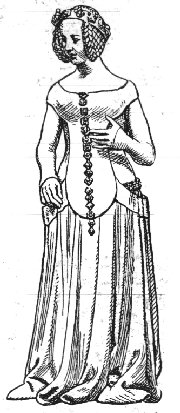|
Garb Seemly and Proper, Part IV: The Fourteenth Century
GeneralThe fourteenth century allowed the development of seriously sexy clothes for both men and women. The most notable development is in the fit of clothing; we see for the first time the close-fitting bodices, tight sleeves and full, trailing skirts which make fourteenth century women so graceful. We also see the development of very short, tight tunics and hose for men; under Richard II in England, these fashions were exaggerated madly to give a most extravagant look, with dagged edges (cut to multiple points, leaf shapes, etc), long trailing sleeves, and the ubiquitous tippet for both men and women. (Tippets are those long trailing strips of fabric which dangle from the elbow, get caught in car doors, and trail in the soup). Most notably, garments were cut more closely to the body, losing the bulky layered look of previous centuries. Men, particularly, revealed their legs with tightly-fitting hose worn under a short tunic; women were no longer forced to cover their heads with voluminous veils, but began wearing their hair in nets. (See the couple depicted on the first page of this newsletter!). Fabric, too, became more elaborate, with patterned brocades and stamped velvets making their way into Europe from the East. As well as this, the growing popularity of heraldry inspired the use of parti-coloured fabric in clothing, and, later in the fourteenth century, the embroidering of heraldic devices on surcoats, gowns and cloaks. A notable feature of this period in England was the enactment of the sumptuary laws in 1363. This was an attempt to control extravagance in matters of dress, and strictly defined the materials permissible for the varying degrees of nobility and peasants. Ermine and other valuable furs, together with pearls, could only be worn by royalty and the most wealthy of the nobles. Wealthy knights and ladies could wear pearls on head-dresses, and were allowed cloth of gold or silver, and jewelled borders; less expensive furs were also permissible. Squires and poorer knights could only wear cloth of silver and silver girdles, and lesser folk were permitted woollens only, and no adornments: "no person under the rank of a knight, or of less property than 200 pounds in lands or tenements, should wear rings, buckles, ouches, girdles, or any other part of their apparel decorated with gold, silver or gems." (Norris)
Menís clothing
Later in the 14th century, the cotehardie developed long, full sleeves. The houppelande also came into fashion towards the end of the century: this was a long, full overtunic with voluminous, full-length sleeves. In the last part of the 14th century, sleeve and tunic hems were frequently dagged, i.e. cut into pointed, circular or leaf-shaped scalloped borders. Men's headgear included the continued use of the hood, now elongated into the dagged liripipe which was wound around the head or neck. The tall-crowned beaver hat, with a turned-up brim, was also worn.
Womenís clothing
It was generally a less modest century. The veil was discarded or greatly reduced in this century: the hair was bound into a net, either at the back of the head or over the ears at both sides. The vertical plaits of the Luttrel psalter appear not to be covered in a net at all. A light veil could be worn, fastened at a point in the centre of the forehead. The reticulated headdress also came into use at this time: this was a stiff wire cage on either side of the face, into which the hair was stuffed. The cages were joined by a crespine, a metal band across the forehead. The nebule headdress was also characteristic of this time: this was a metal cage containing the hair, but was worn across the top of the head and on both sides of the face. Despite the general tendency towards close-fitting garments in both sexes during this period, the mantle remained voluminous. The half-circle mantle was frequently decorated with heraldic devices. BibliographyPhyllis Cunnington, Costume in Pictures (1961). Dutton Vista. Mary G. Houston, Medieval Costume in England and France (1939). London: A&C Black. Francis M. Kelly and Randolph Schwabe, A Short History of Costume and Armour (1931). Batesford. Herbert Norris, Costume and Fashion Nevil Truman, Historic Costuming (1936). Pitman Press.
|





